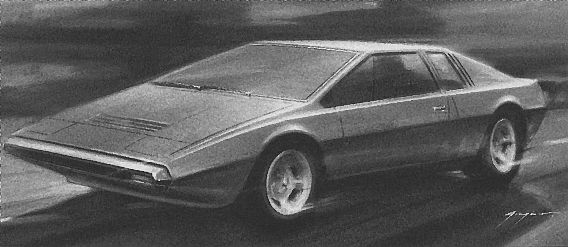
The Giugiaro Esprit shape is an
archetypal example of the Folded Paper design
wonderfully reminisent of that glorious 1970s period of
sportscar production
The sketches above on the
left are Giorgetto Giugiaro's original first renderings of the
striking new Esprit form
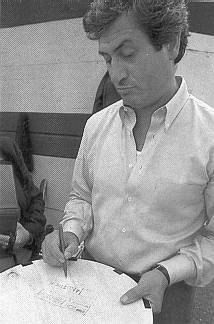
On the right Giugiaro is pictured somewhat later than when he penned the Esprit, around the time of his Lotus Etna design
As the son and grandson of well known Italian
figurative artists, Giorgetto Giugiaro was naturally destined for
an artistic future - during his studies at the Turin Art School,
he enjoyed drawing caricatures of cars and they were displayed at
an end-of-year school show
Dante Giacosa, the Technical Director of
F.I.A.T. happened to see them and immediateIy realised his
talent - by 1955 Giorgetto had joined the company's Styling
Office
In 1959, at the age of only 21, he was offered the position of
manager of the Bertone Stylinq Centre and from here he designed
spectacular coachwork for Alfa Romeo, Aston Martin, Ferrari,
Jaguar, Maserati and other reputed marques
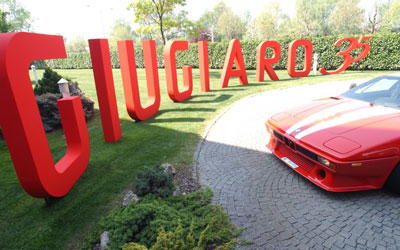
After six highly intense years at Bertone, he moved
to Ghia but he was driven to launch his own company, Ital Styling,
at the end of 1957
The name was changed
to Italdesign
one year later and has since always been one of the leading
players in the field of automobile design
Giorgetto Giugiaro's work was acknowledged in 2000, when he was awarded the supreme title of "Car Designer of the Century" by a panel of 120 top motoring journalists worldwide
A Lotus Europa chassis was modified to match the dimensions of the
new M70 car and it wasshipped it to the Ital Design studio in
Turin, where Giugiaro could work on the body design
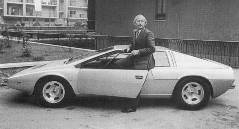 By 1972 the first
protytpe of Project M70, known as "The Silver Car",was ready to
be revealed at that Year's Turin Motor Show
By 1972 the first
protytpe of Project M70, known as "The Silver Car",was ready to
be revealed at that Year's Turin Motor Show
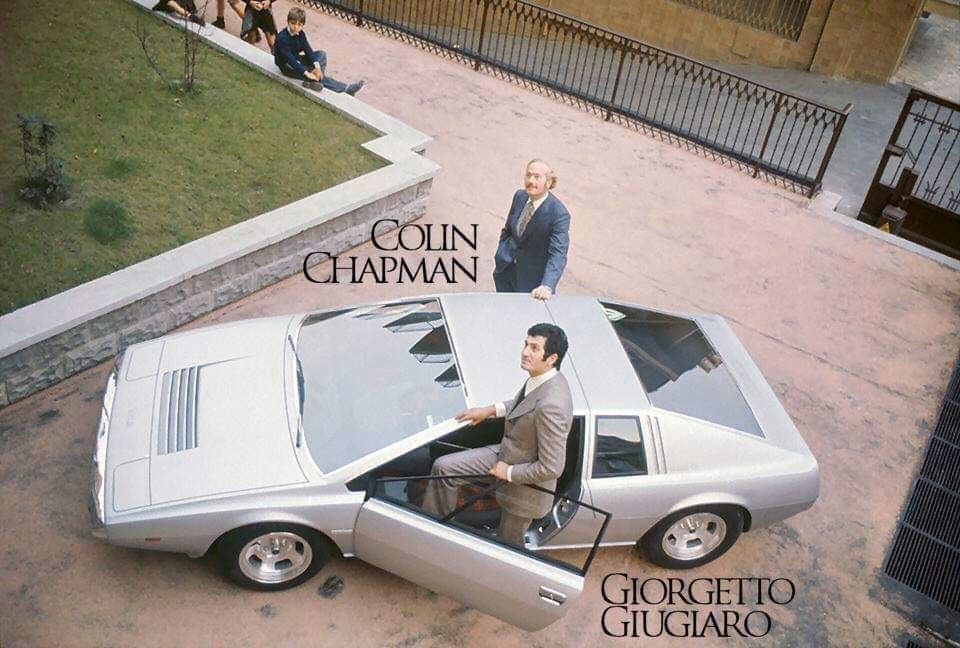
Here's Colin Chapman, pictured with Giorgetto Giugiaro and "The Silver Car" outside some flats in Turin (a secret meeting perhaps?)
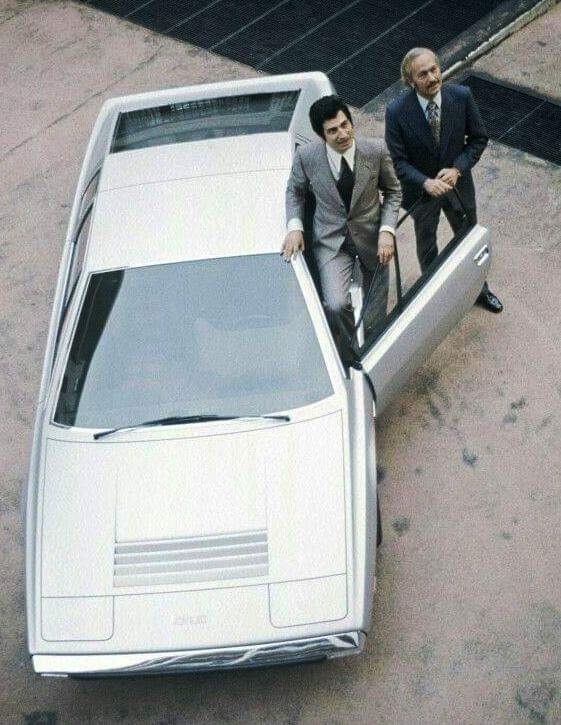
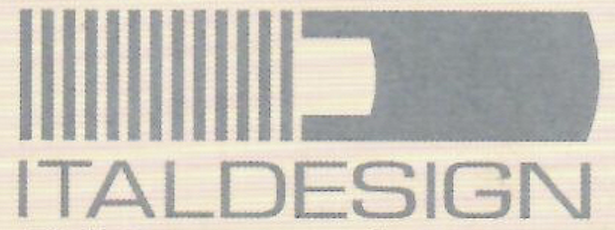
Ital Design had been working on the Lotus concept
car and the Maserati Boomerang over this period and showed them
both, on their stand at the show
The Ital show car, the Silver Car, used aluminum
alloy body panels but prouction of the final M70 design at the
Lotus factory was to be done with a fiberglass body - in view of
this, members of the Lotus design team under the leadership of Oliver
Winterbottom, relocated temporarily to Turin to work
directly with the Ital Design team, who had little experience with
GRP construction techniques
Here is a picture from 1972 of the original clay mock-up of the Esprit from Tony Rudd's book
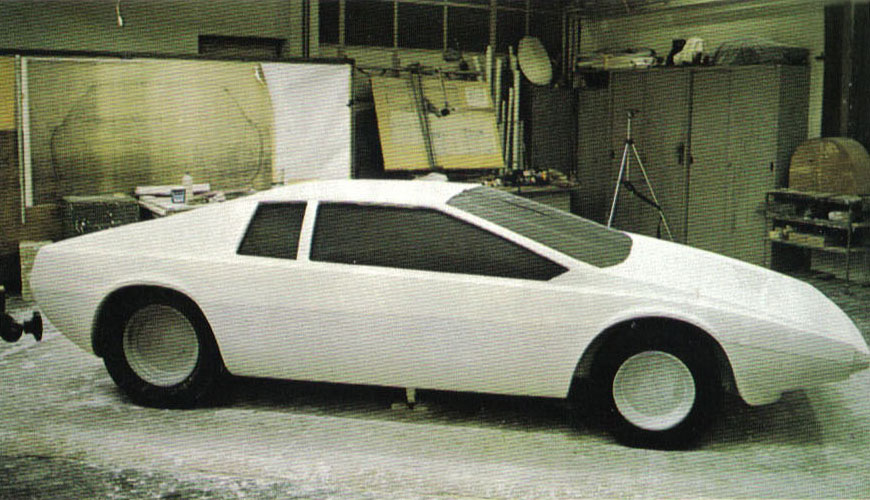
This appears to be full sized, as is normally the case for a clay model a 1/4 scale model was also constructed and taken to the MIRA wind tunnel for aerodynamic testing
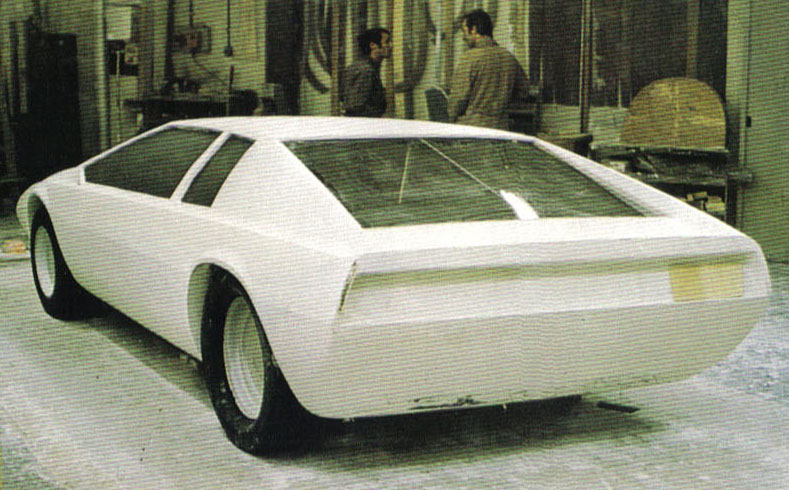
Colin Chapman had suspected that the wedge shape,
although low on drag, would produce postive lift at higher wind
speeds and this was confirmed at MIRA
Changes were made to negate this and also world wide
compliancy changes were also made, one of which was the increase
of the windscreen angle from 19 to 24 degrees for USA regulations
Now Colin Chapman needed to add the engineering know-how to
turn the "SilverCar" into a production version and the test
bed for this was "The Red Car" (shown on the left)
This working prototype, once completed, wore the registration
number IDGG 01
Chapman and Mike Kimberley, the head of Lotus Chief Engineer,
flew to Turin weekly in Colin's Private aircraft and the task of
changing the car into a design that could be produced in GRP by
the Lotus patented VARI (Vacuum Assisted Resin Injection)
technique was tackled - this invloved efftectively splitting
Giugiaro's design in half along its length, in order that it could
be cast in two halves, which would be joined together along the
seam halfway up the sides
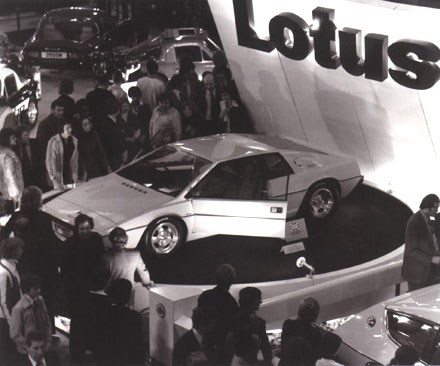
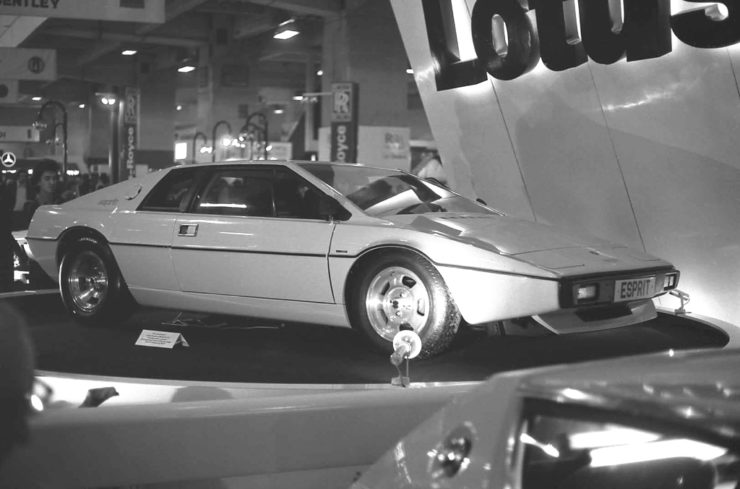
Lotus had first offered an exciting
level of technology to enthusiasts at well below supercar
prices with Europa, as the first mid-engined Lotus road car in
1966 - the basic design of the Esprit, with a steel backbone
chassis and in-line mid-engined layout, was broadly
similar and, as stated, an extended Europa chassis was used for
the early design work at Ital
The overall Esprit concept was quite different though and, aimed for the big league, the Esprit was 13ft 9in long and 6ft 1in wide, making it 7in longer and no less than 9in wider than the Europa
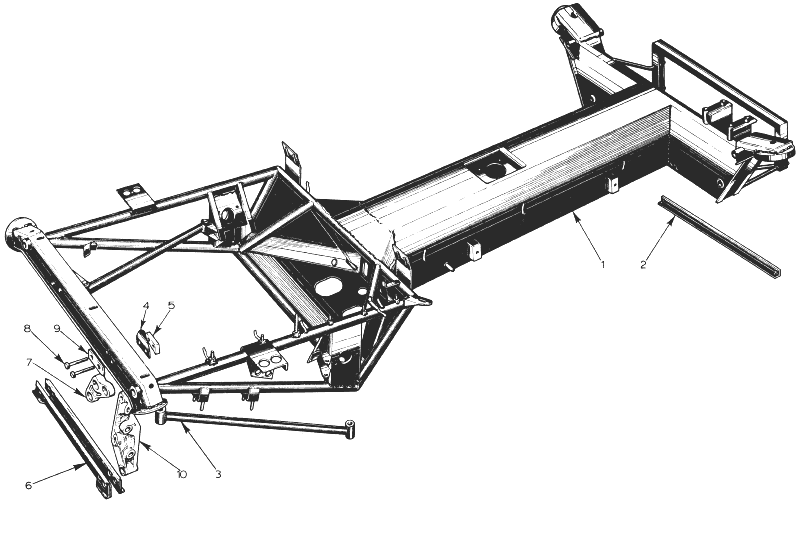 The backbone chassis was finalised and the front
suspension was based on the Opel Ascona/Vauxhall Cavalier - Steering
was rack and pinion, withouy power assistance, which was not used,
even on the future S2, S3 and Esprit Turbo designs
The backbone chassis was finalised and the front
suspension was based on the Opel Ascona/Vauxhall Cavalier - Steering
was rack and pinion, withouy power assistance, which was not used,
even on the future S2, S3 and Esprit Turbo designs
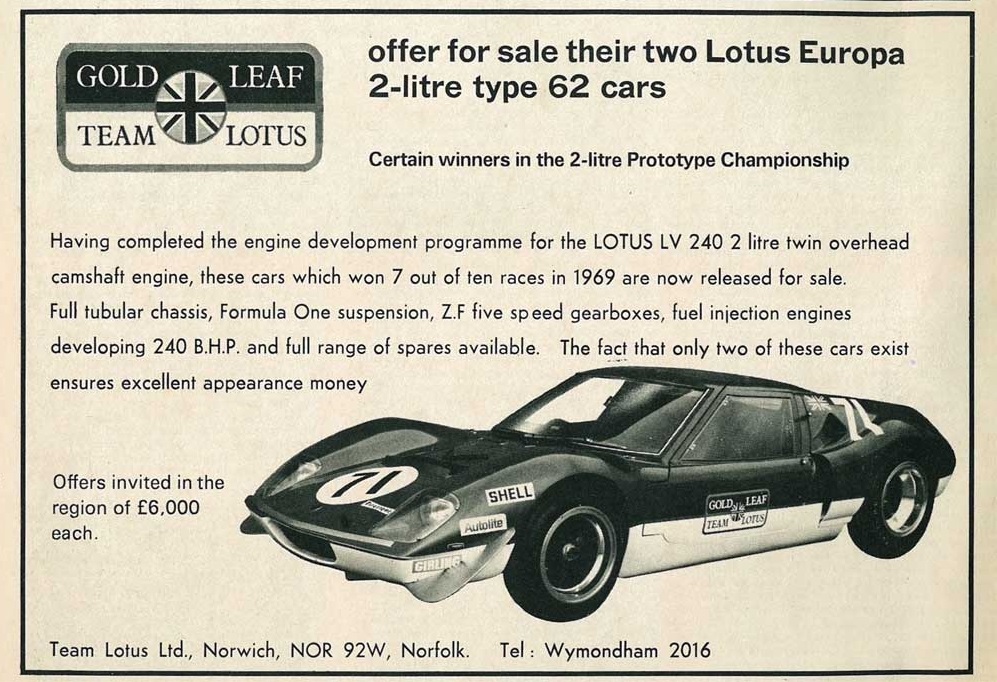
Lotus was by now built its own engines, moving upmarket and away
from the old kit car image and the the engine for the new Esprit
came from the Lotus development program of its own alloy 4
cylinder unit, the 907
Team Lotus had been used to test the basics of the engibe design, by running the earlier 904 engine in the Type 62 racing car
The 904 used a Vauxhall 2 litre iron cylinder block with a Lotus specified long stroke crank and a Lotus prototype cylinder head, which is naturally the more inlvoved area of design - this accelerated the process by using the cylinder block from slant four Vauxhall Victor 2.0, which had a "remarkably" similarly sized bore arrangement...
The hybrid LV220 and LV240 engines names denoted the
Lotus/Vauxhall build and rated horsepower - they were tested in a
Vauxhall Victor, Vauxhall Viva GT and even a Bedford CF van! The
all Lotus alloy 907 used the same 95.25mm bore as the Vauxhall,
with a 69.2mm stroke and sunsequent 1973 cc displacement
.
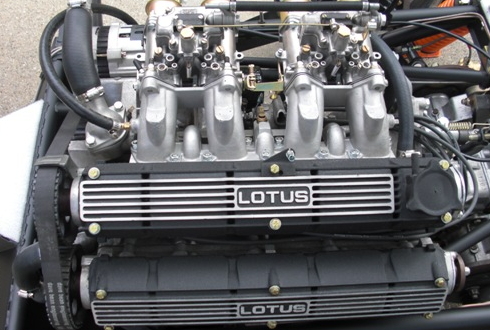
The 907 marked the arrival of Lotus as an independant engine
manufacturer and was very importnat to Colin Chapman
Unfortunately, the almost covert Lotus-Vauxhall program was
seized upon by the motoring press and they risked his wrath by
refering to the all alloy 907 as a Vauxhall or Lotus-Vauxhall
engine!
The 907 was supplied to Jenson Healey as well as to
Chrysler/Talbot for the Lotus Sunbeam
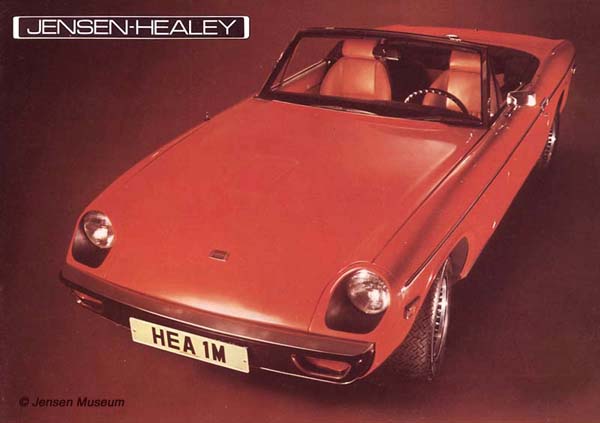
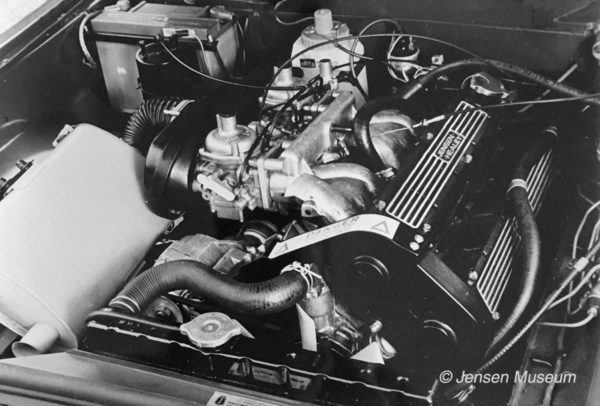
The CitroŽn C35 five speed manual gearbox/transaxle fitted to the
CitroŽn SM and Maserati Merak was selected for the Esprit -
production of the SM was actually ceasing but CitroŽn agreed to
continue production to support the Esprit
The S1 Esprit entered production in June 1976 and, with a light weight of 1,984 lb, its performance figures were considerable for the day - with the relatively small 1,973 cc 907 slant-mounted four-cylinder, double-overhead-camshaft, aluminium engine with twin Dell'Orto carburetors producing 160bhp at 6200rpm, with maximum torque of 140lb ft at 4900rpm
The Esprit S1 was renowned for its green and red tartan interior,
as seen in the James Bondís car
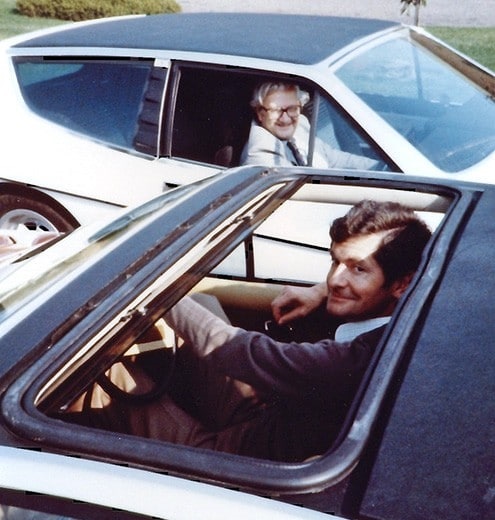
Tony Rudd and Mike Kimberley in an impromptu, or more likley
staged photo, looking like they could be ready to discuss the
developments needed on the Esprit S1 and the future models
Esprit - 1976 - 1977
Esprit S2 - 1978 - 1981
Esprit JPS (John Player Special) - 1978 - 1979
Esprit S2.2 - 1980 - 1981
Esprit Essex - 1980
Esprit S3 - 1981 - 1987
Esprit Turbo - 1981-1986
Esprit Turbo HC - 1987
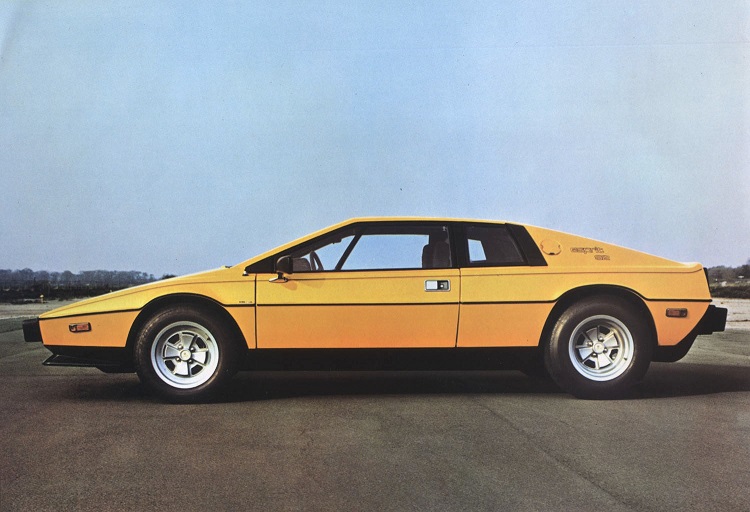
In 1978 the S2 Esprit was launched with improvents
learnt from the S1
The Wolfrace wheels of the S1 were replaced with
Lotus designed Speedline alloy wheels and the S1 Fiat X1/9 rear
lights were dropped for Rover SD1 variants
Cooling ducts were added to the back of the rear
quarter windows and the front spoiler was redesigned by Giugiaro
Changes to the interior included, wider seats and a
revised dash/binnacle layout with seperate Smiths gauges replacing
the S1 Veglia instrument cluster and different illuminated
switches
Colin Chapman had already put the black and gold JPS
livery of John Player & Sons on his Cessna 414-A Chancellor II
private aircraft, which also had the registraion G-PRIX but after
Lotus won the 1978 F1 World Championship, a commemorative edition
Esprit was announced
World Champion Car Constructors badge, with all 7 years as
champions listed, were added to the tailgate and an individually
numbered plaque on the dashboard, with Colin Chapman's signature
May 1980 saw the introduction of the Esprit S2.2
The engine capacity was increased to 2.2 litres and
with it, power was unchanged but torque rose from 140 ft-lbs to
160 ft-lbs
The S2.2 chassis was also galvanised but its design
was unchanged
In a short run Lotus only produced 88 of these
models
Lotus had been working on Project M71, the V8
engined Esprit, but the rising petrol prices from the oil crisis
of the 1970s produced the need for a Lotus factory designed
turbocharged Esprit
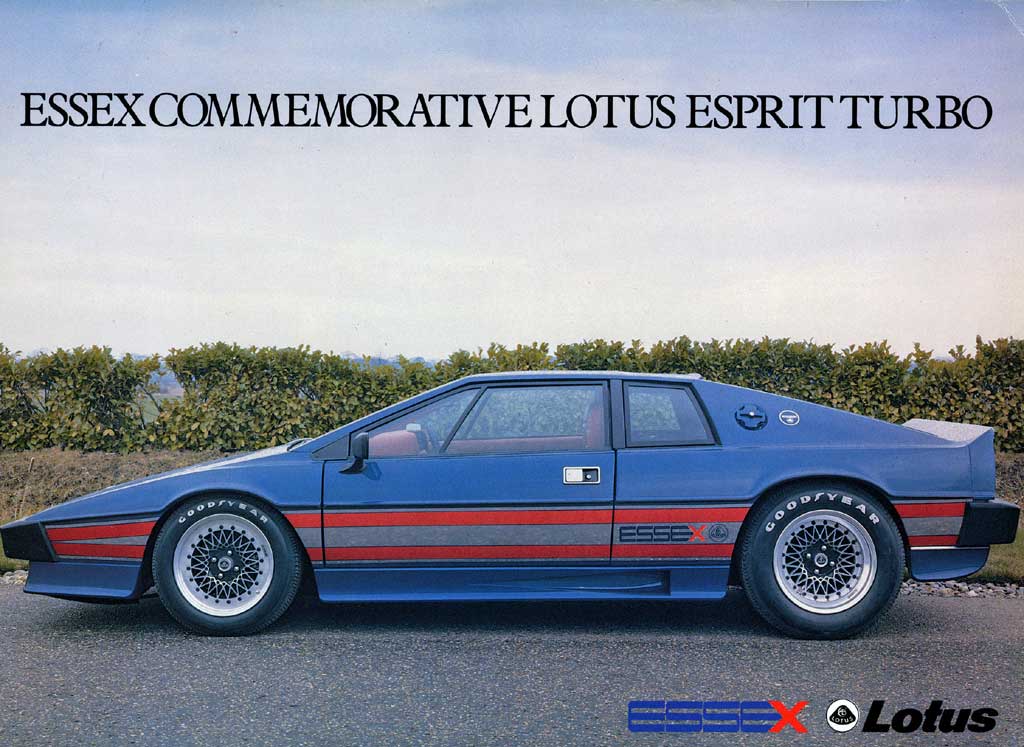
In 1980 a commemorative edition of the Esprit was
unveiled at the Royal Albert Hall, at an event hosted by the Essex
Overseas Petroleum Corporation, the then main sponsor of Team
Lotus in Formula 1
The cars were only available finished in the Essex
colours of blue, red and silver and, although the planned
prodcution was for 100 commemorative cars, only 34
production Essex Turbo Esprits were produced
The cars were fitted with a new 2.2 litre 910-turbo
engine producing 210bhp, with a Garrett AiResearch T3 Turbocharger
providing 8 PSI boost, giving 210 bhp and 200 lb ft torque at
4500rpm - the engine also had a dry dump oil system, with a
toothed-belt oil pump, driven off the crankshaft and two scavenge
pumps
The galvanised chassis and rear suspension were
updated, with the "Chapman Strut" being replaced with an
additional upper link and plunging driveshafts
The braked were uprated and the car was fitted with new three-piece 15 inch Compomotive wheels
Giorgetto Giugiaro was recalled to designed an aerodynamic body
kit for the car, which included a louvered rear tailgate, a larger
front air dam, NACA in side skirts and larger bunpers
Red leather was used for the interior and a unique
roof mounted Panasonic stereo - the dash binnacle now also had a
boost gauge mounted between the speedo and rev counter
![]()
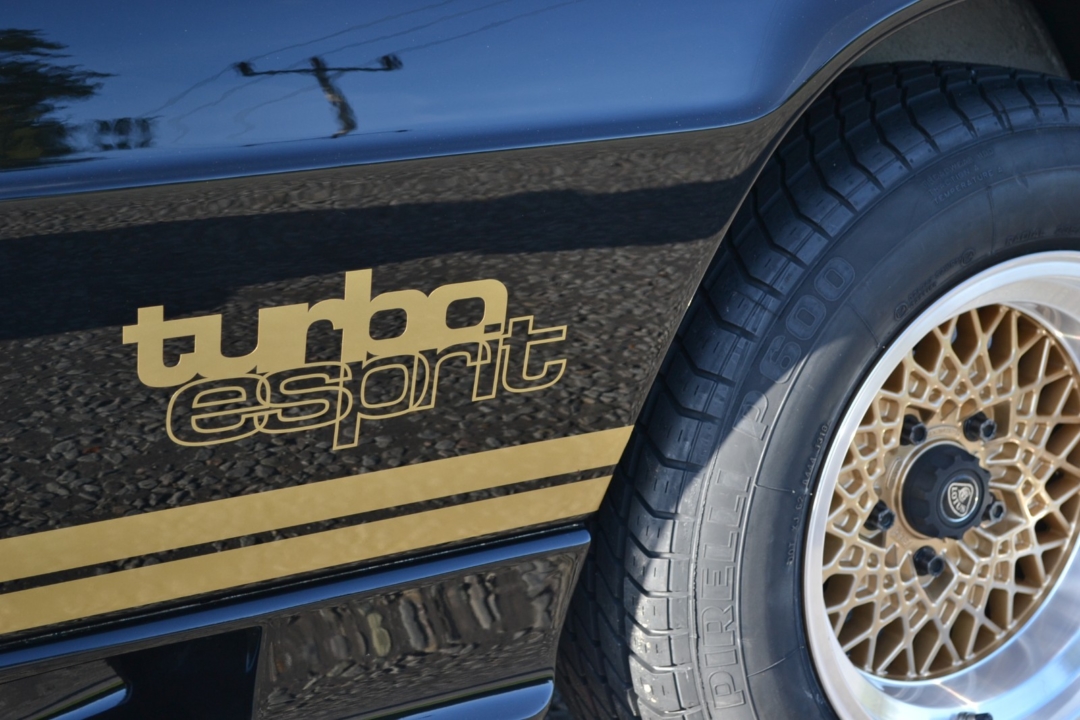
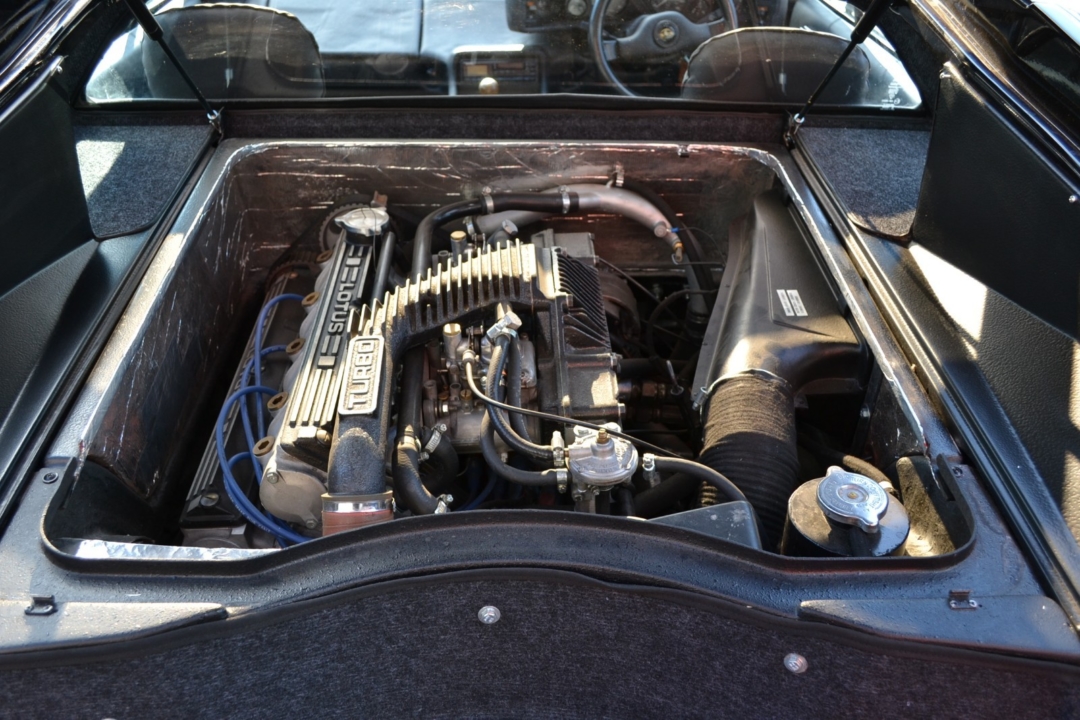
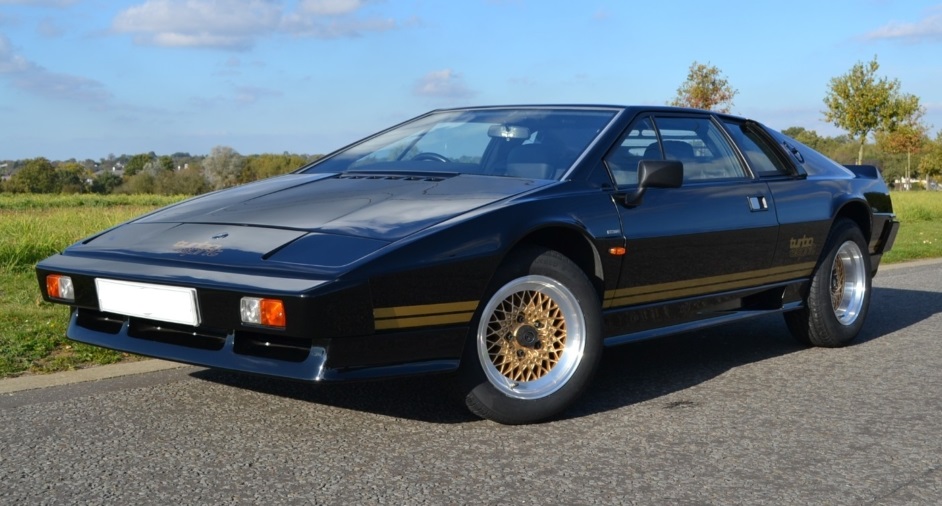
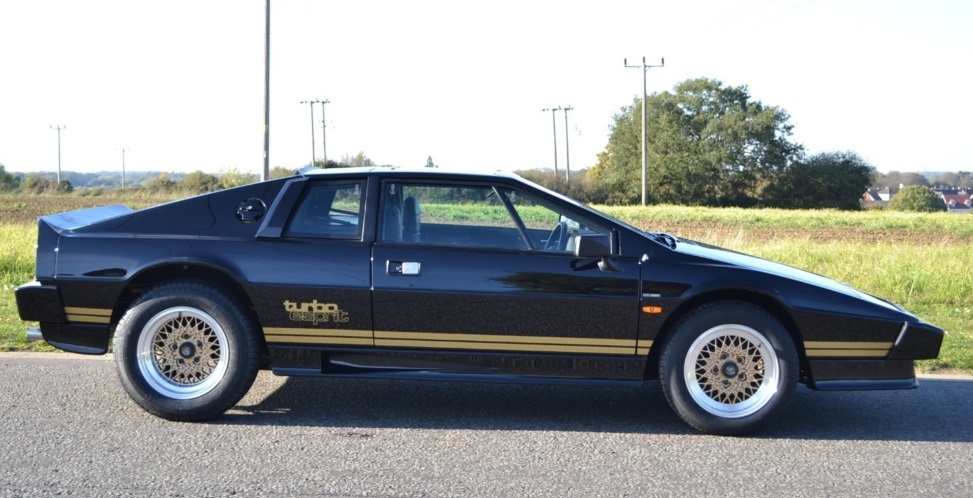
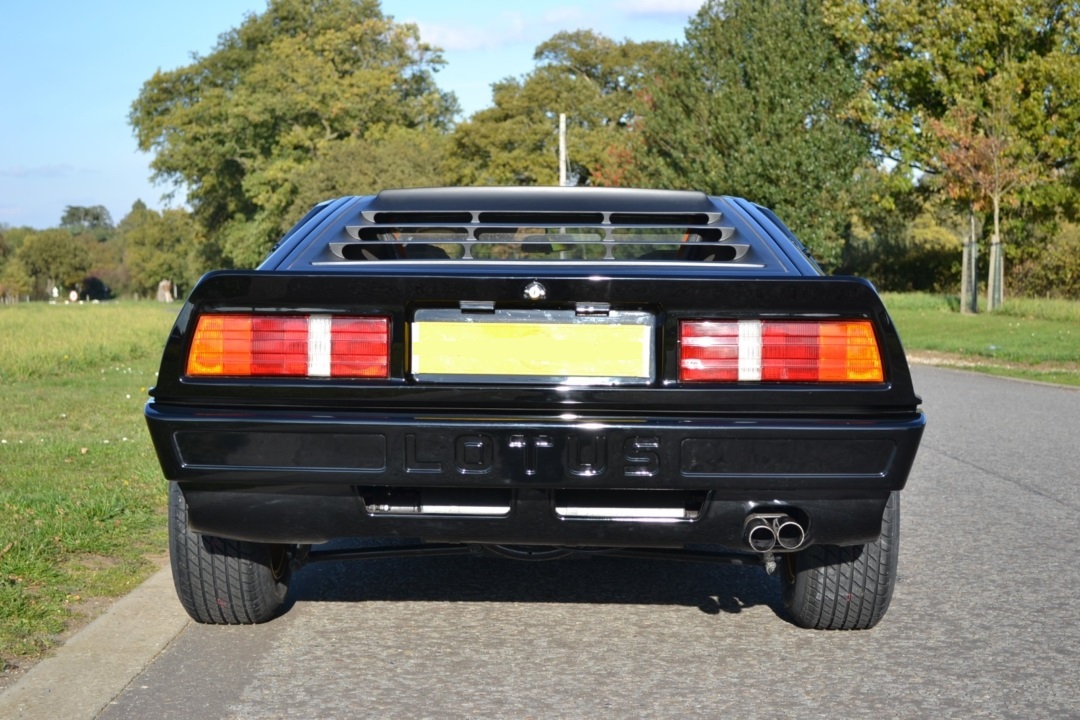
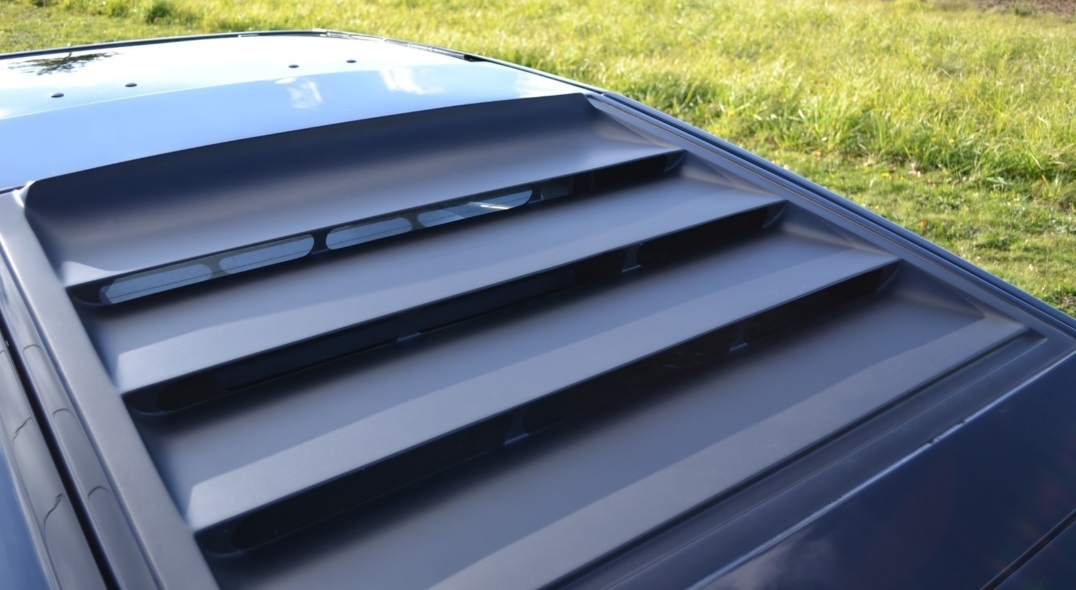
In the mid-Seventies it was invigorating to see such a fresh,
boldly executed, utterly modern sports car
It was very close to Colin Chapman's heart: he was determined to produce it, whatever problems Lotus faced
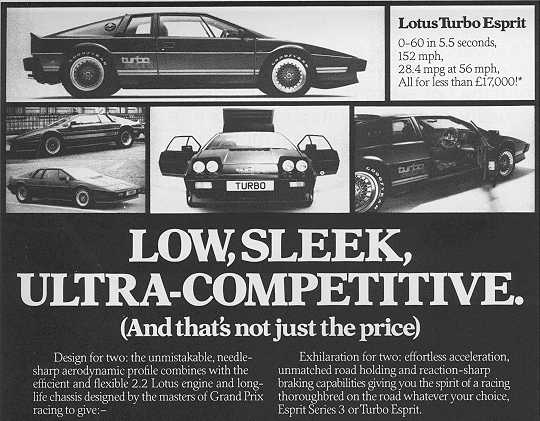
 Click
here for more on the Giugiaro
Turbo Esprit design
and specifications
Click
here for more on the Giugiaro
Turbo Esprit design
and specifications
Click here for production of the Giugiaro Turbo Esprit at the
Lotus factory